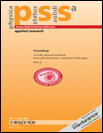Organic and aqueous electrolytes used for etching macro- and mesoporous silicon
Abstract
The aim of this work is to explain the influence of the solvent molecules on silicon dissolution using several hydrofluoric acid containing “organic” electrolytes. The investigations focus on the morphology of the mesopores and macropores and the electrochemical valence of the overall reaction. Some basic properties of the electrolyte (polarity, tendency to form silicon oxide, and the H donor properties) were found to dominate the macropore formation in p-type silicon. For macropore formation the correct balance between the two main dissolution paths (direct silicon dissolution and dissolution via an anodic oxide) is very important. For mesopores in highly doped p- and n-type silicon the direct dissolution is dominant. The consequences of mixing organic and aqueous solutions are discussed.




